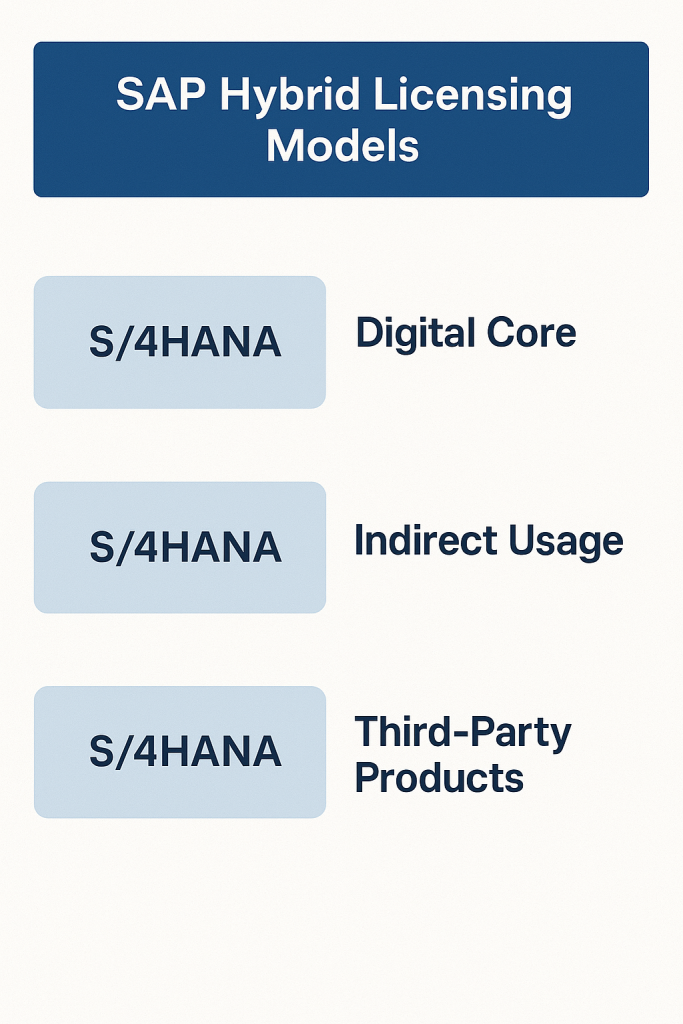
SAP Hybrid Licensing Models
SAP hybrid licensing models enable enterprises to combine traditional on-premise software licenses with modern cloud subscriptions under a single strategy.
This hybrid approach enables IT leaders to modernize their SAP landscape gradually, while controlling costs and minimizing disruption.
Understanding the balance between perpetual and cloud licenses is critical to avoid overspending and lock-in during digital transformation.
Hybrid SAP Licensing Explained
Hybrid licensing refers to the use of both on-premise SAP licenses and cloud subscriptions simultaneously.
For example, a company might keep core ERP on-premise while using cloud-based SAP modules for HR or procurement. The goal is to get the best of both worlds, moving to the cloud at a controlled pace rather than all at once.
In SAP’s traditional model, you pay upfront for a perpetual license plus annual maintenance; in the cloud model, you pay an ongoing subscription for as long as you use the service.
Hybrid licensing often emerges as organizations migrate gradually – you start adopting cloud services but still run legacy SAP systems in parallel.
SAP has conversion programs to help with this (allowing you to swap some on-prem licenses for cloud credits), so you don’t pay twice for the same capability during the transition.
Read SAP License Migration Strategies for ECC, S/4HANA, and RISE Transitions.
Benefits of a Hybrid Approach
- Phased Migration: Move to the cloud in stages. You can pilot new SAP cloud solutions in one area while others remain on-premises, reducing risk and disruption compared to a big-bang migration.
- Maximize Investments: Continue to leverage the money invested in on-premise licenses. As cloud use grows, you can convert or retire on-premises licenses, ensuring that previous investments aren’t wasted and minimizing duplicate spending.
- Negotiation Leverage: Keeping an on-prem alternative gives you bargaining power. SAP is eager to sell cloud subscriptions, so you can use your ability to stay on legacy systems as leverage to secure better pricing or terms for cloud deals.
Challenges and Risks
- Redundant Licensing: During the transition, some users or processes may be licensed twice (on-premises and cloud). Without action, you’ll pay for unused licenses. Regularly identify and retire on-premises licenses that are no longer needed once a function has moved to the cloud.
- Complex Compliance: Two environments mean two sets of license metrics and rules. Cloud services may limit usage by contract, whereas on-premises usage is subject to audits. Integration between cloud and on-prem systems can also trigger indirect usage (e.g., a cloud app creating documents in your on-prem SAP) that needs to be properly licensed. It’s critical to monitor and govern licensing across both environments to avoid compliance issues or surprise bills.
- Contract Lock-In: Cloud contracts often span 3-5 years with predetermined price increases, and on-premises agreements have their own renewal cycles. If not aligned, you could be stuck with inflexible commitments. Ensure your cloud and on-prem contracts allow enough flexibility – for example, include options to adjust user counts or terminate parts of a deal if your needs change. Coordination is key, so you aren’t locked into paying for something you no longer use.
Read On-Premise SAP License Models for IT Leaders.
Negotiating a Hybrid Licensing Deal
- Baseline & Convert: Audit your current SAP usage to see what licenses you can drop, then use SAP’s conversion programs to swap those for cloud subscription credits so you don’t pay for overlapping software.
- Negotiate Flexibility: Insist on contract protections, such as discounts, price caps, a gradual ramp-up, and the right to swap or adjust services. These terms prevent overspending and keep your deal adaptable to change.
Recommendations
- Audit & Monitor: Keep a clear inventory of all SAP users and usage in both environments to catch redundancy and reclaim unused licenses promptly.
- Avoid Double-Pay: Tie cloud adoption to legacy reduction. As you go live with a cloud service, retire the equivalent on-prem licenses (and their maintenance fees) so you never pay twice for the same functionality.
- Plan Long-Term: Model out 5–10-year costs to confirm your hybrid plan saves money. If not, adjust the plan or negotiate deeper discounts before making a commitment.
- Demand Flexibility: Include clauses that let you adjust volumes or exit services if needed so you’re not trapped in a deal that no longer fits your business.
- Co-Term Contracts: Align renewal dates across cloud and on-premises, providing you with periodic opportunities to rebalance your license mix and negotiate with maximum leverage.
FAQ
Q: When is a hybrid SAP licensing model the right choice?
A: When you need to move to the SAP cloud gradually without abandoning important on-prem systems. It’s the go-to approach for a safe, phased migration.
Q: Can we convert on-premise SAP licenses into cloud subscriptions?
A: Yes – SAP lets you convert certain on-prem licenses into cloud subscriptions, so you can stop paying maintenance on the old system and avoid double-paying during the switch.
Q: How do we stay compliant with SAP licensing in a hybrid environment?
A: Manage both environments together – centralize user license assignment and monitor any cloud-to-on-prem data flows (indirect use) to ensure everything is properly licensed. Regular internal audits will catch issues early.
Q: Is RISE with SAP useful for hybrid scenarios?
A: RISE is SAP’s all-in-one S/4HANA cloud offering. It can be part of a hybrid setup (moving core ERP to SAP’s cloud while some systems stay on-prem), but it’s a rigid long-term deal – evaluate if its one-size-fits-all contract gives you enough flexibility.
Q: What’s the best way to control costs during a hybrid transition?
A: Be proactive: negotiate strong discounts, avoid buying more cloud capacity than needed, and continuously eliminate unused licenses (both on-premises and cloud) to avoid paying for shelfware. Regularly review usage and costs to adjust contracts and keep spend in check.
Read more about our SAP Licensing Services.